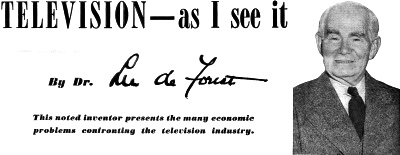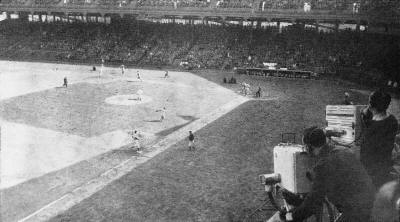|
Now that the inestimable
Bob Pease is no longer with us to enlighten and entertain, is
there a contemporary and immediately recognizable electronics technology name you
see on a magazine article, book, or presentation? Maybe my tech literary world is
pretty small, but nobody come to mind as I write this (apologies to the many great
authors I am forgetting). In the early part of the last century, you can be sure
that when the names Edison, de Forest, Tesla, Marconi, Bell, and Morse were
featured in bylines, readers took note. Lee de Forest's 1945 article in
this 1945 Radio-News magazine on the
state of the art of television was an example. No doubt many reports on TV were
written, published, and passed over, but when one of the Greats of the industry
put pen to paper it will be noticed. It worked with me.
Television - As I See It
By Dr. Lee de Forest
 This noted inventor presents the many economic
problems confronting the television industry. This noted inventor presents the many economic
problems confronting the television industry.
In the Foreword of my recent book, "Television Today and Tomorrow," I wrote:
"To see from a distance details that defy telescopic vision; to have sight through
barriers, to recreate in the home, in a million homes, not merely messages and music
for the ear, but actual scenes as they transpire miles beyond the horizon, across
continents;
"To summon the apparition of loved ones far removed; to bring into one's room
an athletic field, a race track, a ship sailing a far sea; in fireside comfort to
meet and hear the nation's leaders as they counsel, instruct, and inspire; to annihilate
space and separation, to enrich the home lives of modern millions through the medium
of the mightiest miracle which science has ever yet conceived -
"This is Television!"
These glowing sentences briefly epitomize, in my opinion, the future scope and
humanitarian possibilities of this youngest and most attractive of all the offspring
of what now is known as Radio. This child, after a discouraging and tedious infancy,
was growing into attractive adolescence - during the last years of the second decade
of the Electronic Era, when it was suddenly nipped in the bud by the total blackout
imposed by our entry into this World War.
But in a hundred research laboratories intense, war-incited work along electronic
lines closely akin to those involved in television has been carried on, advancing
the knowledge of phenomena and principles needed for the vastly improved forms of
television which science and technology will present shortly to an eagerly waiting
world, once the obliterating war clouds have rolled away.
As was the case with radio after World War I, this war-incited development will
be found to have hastened by many years the advancement of the television art, over
what an orderly, peacetime evolution would have registered.
So we shall find shortly that the new television picture, like a butterfly, has
broken out from the small conical-shaped glass chrysalis of the cathode-ray tube,
and spread its newly formed wings wide upon the screen wall, there to be beheld,
not by a few huddled heads, but in the comfort of arm chairs and sofas at convenient
distances, in the living rooms of ten million homes. And like a gorgeous butterfly,
the new television picture will glow in brilliant natural colors - not always -
there will be abundant black and white scenes - but from the more elaborate, somewhat
costlier sets will be projected those fascinating motion pictures in color which
now make Technicolor productions and Kodachrome home movies so incomparably more
natural and attractive than drab black and white can ever be.
How, you ask, can these things come to pass? By the enlightened rulings of the
Federal Communications Commission which will give to the telecasting industry coveted
niches in the upper regions of the radio spectrum, away from a great deal of interference
which formerly plagued its audiences, regions where there exists abundant room for
video band frequencies 20 or more megacycles wide. This calls for video carrier-wave
frequencies well above 150 megacycles, perhaps as high as 700, or even higher. It
now has been proven that powerful television transmitters operating on such frequencies
not only can be constructed, but these have demonstrated a radiation efficiency
in excess of those heretofore attained with much longer wavelengths, of the standard
order of 5 meters.
The receiving antenna for use with these new fractional meter wavelengths are
smaller, less conspicuous, and more readily erected and serviced. They therefore
can be located more easily and shielded from stray radiations which produce the
annoying ghost images upon some television-receiver screens. Also, these small antennas
are more immune to pick-ups from extraneous, manmade interferences.
From them small coaxial cables will lead the picture and audio ether signals
down to the receiver cabinet whence the picture will be projected to the viewing
screen; either a trans-lux one, attached to cabinet for "rear projection" from the
Kenetron tube, or on to a beaded screen hung upon the wall, or suspended from a
tripod, as with the home-movie projector.
|

Baseball game being televised. All major sports events will be brought directly
to the home via television. |
This new-era television probably will grow up alongside of the old fashioned
prewar type and standards (a 525-line picture radiated on what we now must regard
as "long" wavelengths - of the order of 5 meters). The existing "television plant,"
comprising those large companies, which deserve much of the credit for developing
this art from its inception, have many millions of dollars invested in their prewar
transmitter stations. Also there are some thousands of prewar receivers, and the
radio manufacturing companies are all set up to turn out their "archaic" types of
television receivers in mass production, to operate with existing transmitters.
The evolving situation, however, will resemble much the manner in which FM is growing
up alongside of its older brother, AM, there being identical programs on both. Telecasting
stations will send out the same picture program from both the old and new type of
transmitters, low- and high-carrier frequencies; moderate definition pictures for
direct tube-end viewing; and high definition, 700 to 1000 line, pictures for screen
projection, comparable in every way with our 16-mm. motion pictures. The prewar
standards are wholly ill-suited for three-color pictures, whereas color attachments
for use with the new, projection type of c.b. tubes will be so small and simple
as to add but slightly to the cost of the black-and-white receiver instruments.
Synchronism has proven to be no problem.
So it would appear that the not-too-distant future of television in the home
is indeed promising. We know now how this vastly important advancement of the art
actually can be realized. Only the element of time required for its realization
remains undecided. But we know this need not be long. Two years should be more than
ample; 1946 should witness this vastly significant transformation.
And now a word as to the economics involved. Lacking a highly desirable, well-deserved,
governmental "lend-lease" television policy, the new industry obviously must "lift
itself up by its boot-straps." I mean, before it can pay for the live spot entertainment
that will cause millions to view, and continue to view, their television screens,
the industry must go into the financial infrared. The high cost of producing good,
live, nightly shows, creditably enacted by skilled name artists - shows which are
perfectly rehearsed at high expense, then flashed on the screens of but a single
city, or even two or three, only once, and then vanish forever - such cost would
swiftly bankrupt any broadcasting organization. This situation would last at least
until the audiences could be built up, by relay and coaxial chains, into the millions
which alone will interest lavishly paying sponsors. And each telecasting chain will
cost enormously in coin and time.
The economic solution of this "insoluble" paradox is quite simple - to some executives
uninterestingly commonplace and undramatic. It resides in celluloid! The necessary
telecasting chains exist already - the postal service, railway and air express -
and the humble tin film-carrying can!
And here is where the motion-picture industry stands complete, all ready to help
solve this ridiculous riddle. Erect television transmitters (new type) in 50 cities
(already more than that number of applications are before the FCC). Produce your
entertainment in the motion picture studios - shorts and semilongs, all of good
quality - made perfect for presentation by cutting and splicing, like in any moving
picture. Ship the prints to every transmitter, to be used whenever desired and as
often as desired, passing them on from city to city so that the rapidly swelling
audience volume will be kept entertained constantly. Thus, any television picture
will be viewed by such numbers as to be interesting to the commercial sponsors.
The cost per viewer thus will be so reduced that profits in the making and telecasting
processes soon will become apparent-and very enticing.
Nine-tenths of television entertainment will be from film - which factor at once
eliminates a host of problems, financial and otherwise.
Spot news, athletic games, horse racing, unusual events, providing these chance
to occur at suitable hours, will prove intensely interesting to theater audiences,
of course, as well as the viewer at home. But this quality of "simultaneity" in
television has been vastly overstressed. Who fails to be interested or delighted
in a motion picture simply because they know that the figures on the screen had
enacted that scene many months before? Far better a good picture than a low-quality
show. The film is certain to play in television an even more vitally important role
than does the transcription and phone-record in broadcasting. Vastly more, for upon
film entertainment will depend the very life of television.
One word more covering television in the theater. Cinema screen television pictures
have long been a demonstrated fact - in New York by R.C.A. and in London by Scophony
and Beard.
The new projection tubes now under development will throw upon the theater screen
pictures almost as brilliant as we now see thereon. I have in mind one such tube
which will permit the use of the regular theater projection arc light, instead of
depending on a terrifically bombarded, short lived, fluorescent projection area.
Such an optical device will enable us to place brilliant pictures in all the
richness of living, natural colors before the eyes of large theater audiences. For
color in television will soon dominate that art, even as Technicolor is now rapidly
assuming a capital importance in the motion picture industry. For the theater also
it will readily be possible to register the incoming telecast picture upon film,
so that the evening audiences may witness the same exciting horse-race finish, or
football game which had thrilled the afternoon audiences a few hours earlier. Thus,
the home owner will have a permanent record, perhaps an exclusive one, for his ensuing
audiences. The possibilities along these lines are a challenge to our imagination.
Science will provide all the needed implements. It will be up to the motion picture
industry amply to employ them.
Therefore it well behooves the great motion picture industry to look well, and
now, to television. For this new instrument is most emphatically certain to play
a heavy role in that industry, and at an early date. They had best book this show,
for it can help or harm them ,"colossally"!
Like the sound-on-film, television cannot be suppressed, dare not be ignored.
Let the film magnates forget not the lesson learned in the late twenties, or television
will cost them plenty!
Color and Monochrome (B&W) Television
Articles
Posted November 29, 2021
(updated from original post on 11/7/2014)
|









 This noted inventor presents the many economic
problems confronting the television industry.
This noted inventor presents the many economic
problems confronting the television industry. 
